My final project is develop a simulation of the new Omicron variable of Covid-19 in my state, using the SEIR model and Java, so, I was read some articles about how the SEIR model works and I have the equations needed to do it, are the followings:
- N: Total of population (4,132,000)
- S: Susceptible (Non-infected)
- E: Exposed (Infected but not infectious yet)
- I: Infected (Infected and infectious, I'm using 1)
- R: Recovered or Dead
- µ: Mortality rate (0.18)
- β: Infection rate (for my State, I'm using 0.5)
- ν: Vaccinated population (56.7%)
- σ: Contagious rate (also named as R0, for Covid-19 I'm using 2.33, 2.6 and 5.0)
- Y: Recovered rate (for my state, I'm using 93%)
So, I try to put these variables into my code and it didn't work, here is my code:
package project;
import org.jfree.chart.ChartFactory;
import org.jfree.chart.ChartPanel;
import org.jfree.chart.JFreeChart;
import org.jfree.chart.plot.PlotOrientation;
import org.jfree.chart.plot.XYPlot;
import org.jfree.chart.renderer.xy.XYLineAndShapeRenderer;
import org.jfree.data.xy.XYSeries;
import org.jfree.data.xy.XYSeriesCollection;
import javax.swing.*;
import java.awt.*;
import java.util.ArrayList;
import java.util.List;
public class SEIR {
int totalDias = 200; // Days to simulate
int N = 4132000; // Population
// SEIR model variables
int I0 = 1; // Infected initial
int E0 = 1; // Exposed initial
double beta = 0.5; // Infection rate
double gamma = 1.0/10.0; // Recovery time
double a = 1.0/2.0; // Incubation period
double mi = 0.18; // Death rate
double ipsilon = 0.567; // Vaccinated population
double gamma2 = 0.93; // Recovered rate
double sigma = 2.33; // R0, it can change to 2.6 or 5.0
List<Double> S = new ArrayList<>();
List<Double> E = new ArrayList<>();
List<Double> I = new ArrayList<>();
List<Double> R = new ArrayList<>();
private void iniciarSimulacionSEIR() {
XYSeries lineaS = new XYSeries("S");
XYSeries lineaE = new XYSeries("E");
XYSeries lineaI = new XYSeries("I");
XYSeries lineaR = new XYSeries("R");
final int R0 = 0; // Recovered initial
final int S0 = N - E0 - I0 - R0; // Susceptible population (population - Exposed - Infected - Recovered)
// Adding the initial values
S.add((double) S0);
E.add((double) E0);
I.add((double) I0);
R.add((double) R0);
for (int dia=1; dia<totalDias+1; dia++) {
double[] ecuaciones = calculo1(dia);
S.add(ecuaciones[0]);
E.add(ecuaciones[1]);
I.add(ecuaciones[2]);
R.add(ecuaciones[3]);
// Adding the values for S, E, I and R on each of the lines to be plotted
lineaS.add(dia, S.get(dia));
lineaE.add(dia, E.get(dia));
lineaI.add(dia, I.get(dia));
lineaR.add(dia, R.get(dia));
// Printing the values for S, E, I and R day by day
System.out.println("S: "+S.get(dia)+" in day: "+dia);
System.out.println("E: "+E.get(dia)+" in day: "+dia);
System.out.println("I: "+I.get(dia)+" in day: "+dia);
System.out.println("R: "+R.get(dia)+" in day: "+dia+"\n");
}
// The collection for our 4 lines to graph
XYSeriesCollection datacol = new XYSeriesCollection();
datacol.addSeries(lineaS);
datacol.addSeries(lineaE);
datacol.addSeries(lineaI);
datacol.addSeries(lineaR);
JFreeChart xyLineChart = ChartFactory.createXYLineChart(
"Simulación de la variable ómicron en Oaxaca", // Title
"Días", // Data tag
"Población", // Values tag
datacol, // Data
PlotOrientation.VERTICAL, // orientation
true, // Include legend
true, // Include tooltips
false // urls
);
XYPlot plot = xyLineChart.getXYPlot();
// This part adds color and size for each line
XYLineAndShapeRenderer renderer = new XYLineAndShapeRenderer();
renderer.setSeriesPaint(0, Color.RED);
renderer.setSeriesPaint(1, Color.GREEN);
renderer.setSeriesPaint(2, Color.YELLOW);
renderer.setSeriesPaint(3, Color.BLUE);
renderer.setSeriesStroke(0, new BasicStroke(2.0f));
renderer.setSeriesStroke(1, new BasicStroke(2.0f));
renderer.setSeriesStroke(2, new BasicStroke(2.0f));
renderer.setSeriesStroke(3, new BasicStroke(2.0f));
plot.setRenderer(renderer);
ChartPanel panel = new ChartPanel(xyLineChart);
// Create the frame
JFrame ventana = new JFrame("Simulador");
ventana.setVisible(true);
ventana.setSize(800, 600);
ventana.setDefaultCloseOperation(JFrame.EXIT_ON_CLOSE);
ventana.add(panel);
}
private double[] calculoSEIR(int dia) {
dia = dia - 1;
double dS = (beta * S.get(dia) * I.get(dia)) / N;
double newS = S.get(dia) - (dS);
double newE = E.get(dia) + (dS - (a * E.get(dia)));
double newI = I.get(dia) + ((a * E.get(dia)) - (gamma * I.get(dia)));
double newR = R.get(dia) + (gamma * I.get(dia));
return new double[] {newS, newE, newI, newR};
}
private double[] calculo1(int dia) {
dia = dia -1;
// These variables are just for shortening the 4 equations of the model
double SIN = (S.get(dia)*I.get(dia)) / N;
double VS = ipsilon*S.get(dia);
// 1st equation (dS/dt)
double dS = mi*(N-S.get(dia)) - beta * SIN - VS;
// 2nd equation (dE/dt)
double dE = (beta * SIN) - (mi+sigma)* E.get(dia);
// 3rd equation (dI/dt)
double dI = sigma*E.get(dia)-(gamma2+mi)*I.get(dia);
// 4th equation (dR/dt)
double dR = gamma2*I.get(dia)-mi*R.get(dia)+VS;
return new double[] {dS, dE, dI, dR};
}
public SEIR() {
iniciarSimulacionSEIR();
}
public static void main(String[] args) {
new SEIR();
}
}
It doesn't work when I compile it, here's an image of my result:

Luckily, I found this question in StackOverflow which was very helpful, I made some adjustments to use my own data and modify the method calling in line 56, as the follow: I just have to change this line (inside the for loop):
double[] ecuaciones = calculo1(dia);
for this one:
double[] ecuaciones = calculoSEIR(dia);
And the result is the following:

So, it works, but I don't know properly how it works and I'm not using the original model, instead of this one I'm using the model and equations (also a SEIR model) that I found in the other question and that's how I finally be able to make it work, I'll really apreciate if someone can help me with this, there is some way I can use the proposed model at the first? or it's better to me just not touch it anymore and leave it like this? Also, my teacher asked me for 2 more simulation models apart from the SEIR, could someone recommend me some that is not so complicated to implement in Java?
Thank you for reading all!!

